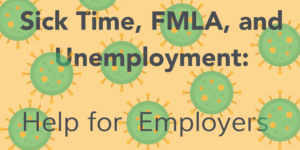
Are you an employer—or former employer—struggling to understand how to support a domestic worker in this moment of uncertainty and fear? Helping them parse the finer points of unemployment insurance and the new relief packages is one huge way that you can support your worker if you are in the unfortunate position of having to end your professional relationship if your own income situation changes. Please note that Hand in Hand advocates for employers to continue paying their employees if at all possible, because the person you hired is depending on you to survive in these uncertain times. If you are still paying your employee as you always have, please sign our pledge!
We know that not everyone is in the position to continue paying their employees, so finding other tangible opportunities to support our employees is important. But understanding the Families First and other relief legislation is incredibly hard, so we’re taking on some of that challenge for you.
Hand in Hand understands that the domestic work has long been perceived as “informal” work. In fact, some say it’s the original “gig economy” position. It means that for both workers and employers, workers are often not paid “on the books.” However, when possible, paying legally is the best option to ensure that your employee has access to protections and benefits that can be crucial during moments like the one we are facing. Our friends at Nest Payroll have some excellent resources to get up to speed if you want to make sure that your employee—current or former—has access to the benefits of new protections.
**Caveat: Hand in Hand is not an accounting firm, payroll agency, or a law firm! We are doing our best with, along with our friends at other organizations and companies, to parse new information as it comes out. We will do our best to make sure this information is up-to-date, but know that things are changing regularly with regards to coverage, eligibility, and benefits.**
Key Questions
Is the Families First Coronavirus Response Act [FFCRA] in effect now?
- Yes! It is in effect as of April 1st, and eligible employees can make claims until 12/31/2020.
What are my basic obligations under the FFCRA?
- Employers are responsible for 2 weeks paid sick leave and 10 weeks paid family leave
I employ someone part-time. What are my obligations?
- Employers are obligated to provide paid leave for part-time employees as well as full-time employees. See question 5 in this helpful link from the Department of Labor for details.
My employee has already used some of their paid time off. Do they get more through this act?
- Yes they do. This act guarantees paid leave on top of any other accrued leave that your employee has accrued.
Do I have a “Qualifying Reason” to pay my employee and be reimbursed?
- If you’re quarantined (not sheltering in place) due to exposure
- If you have an employee whose child is home from school
- If you have symptoms of COVID-19
- See more qualifying reasons from the Department of Labor here
Is my employee eligible for unemployment insurance?
- This gets into some murky “legal to work” territory, which can be hard to talk about! Please see our blog on difficult conversations to approach this with careful intention. For further details, please see the National Employment Law Project’s resource.
- Is your employee paid “on the books”? Even if they weren’t in 2019, you can make sure they have access to unemployment now.
What is Family and Medical Leave and who qualifies?
- Family and Medical Leave is available to employees who are “unable to work or telework due to a need for leave to care for a child of such employee if the child’s school or place of care has been closed, or because the child care provider of the child is unavailable, due to COVID-19 related reasons” (source here)
- Employers are obligated to pay for up to ten weeks after the first ten days of leave; during the first ten days of leave, employees may use other paid time off benfits. (See question 10 in this helpful link from the Department of Labor for details.)
Can I furlough my domestic worker? What happens then?
- Furloughed workers—in other words, employees who are expected to come back to their jobs in your home as soon as possible— are not eligible to receive paid time off, so this option is best to take after you’ve exhausted all types of paid time off.
- When applying for unemployment insurance, your employee can report that they are on “standby” in order to avoid having to apply for work in the interim.
Who qualifies for the stimulus checks?
- Anyone who has filed taxes in 2018 or 2019 and has earned under $99,000 per year qualifies for the stimulus check.
Do you need to have filed your taxes to receive the stimulus check?
- Short answer: yes. But if you haven’t yet filed for 2019, your check will be based on your 2018 taxes.
Fact Sheets & FAQs
- Department of Labor Employee Rights Fact Sheet
- Department of Labor FAQ
- National Employment Law Project: Understanding the Unemployment Provisions of FFCRA
- A Better Balance: FFCRA and CARES Fact Sheet
- Nest Payroll: Why now is the time to get caught up on payroll taxes, for free!
